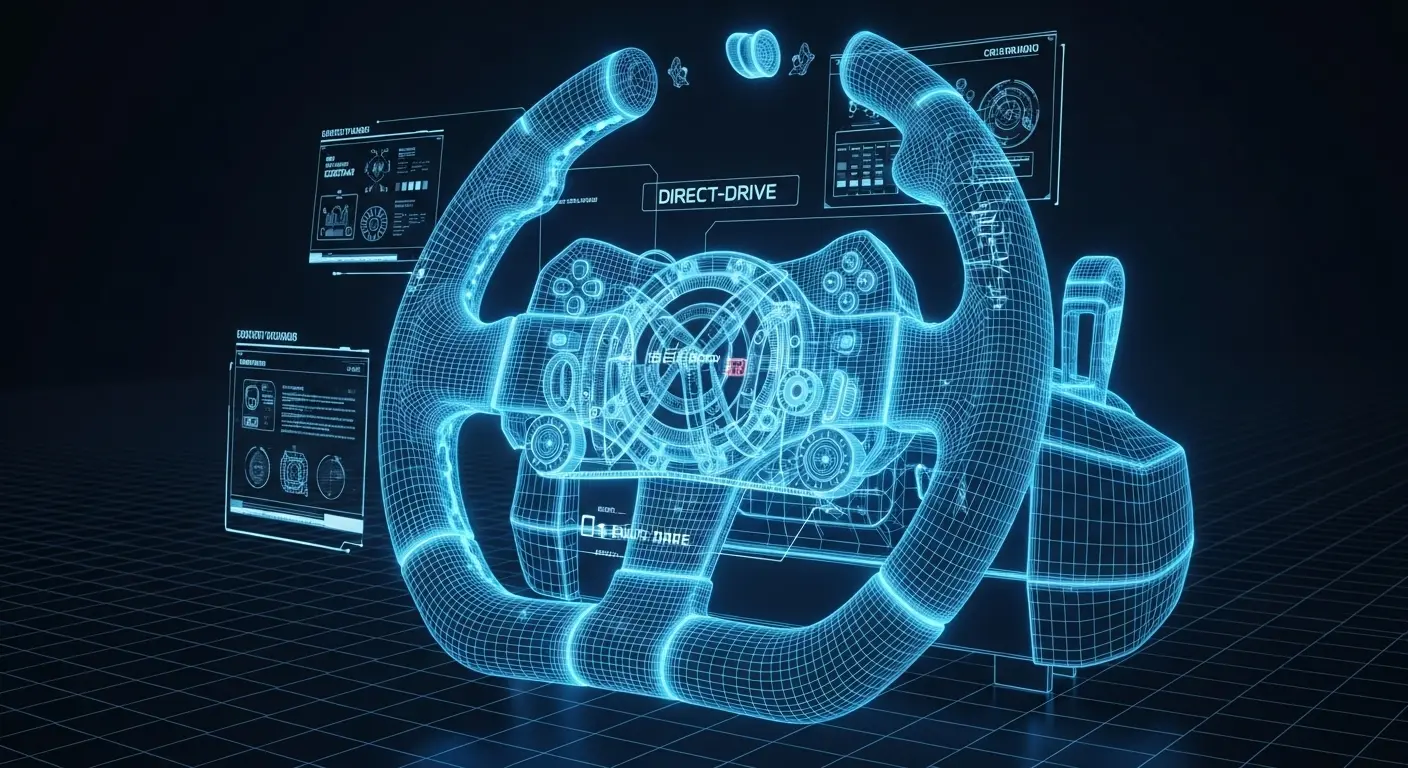You feel it, don’t you? That nagging sense that something is missing. You’ve nailed the perfect racing line, your car is tuned to perfection, but you’re still wrestling with a thumbstick on a controller. You feather the trigger for throttle control, but it feels vague, disconnected. You’re hitting the apex, but you aren’t feeling it.
Welcome to the inflection point that every serious racing game enthusiast reaches. It’s the moment you realize that to truly bridge the gap between playing a game and living a simulation, you need to leave the controller behind.
A racing wheel is more than just a different type of controller; it’s a gateway to immersion. It’s the conduit through which the digital physics of the game are translated into tangible forces you can feel in your hands. It’s the difference between telling your car what to do and having a conversation with it.
But stepping into this world can be daunting. You’re bombarded with acronyms like FFB and DD, debates about belts vs. gears, and price tags that range from a fun weekend purchase to a serious investment.
That’s what this guide is for.
Over the next ten minutes, we will demystify every aspect of choosing a racing wheel. We will build your knowledge from the ground up, transforming you from a curious beginner into an informed buyer ready to make the perfect choice for your budget, your games, and your ambition. By the end of this guide, you will understand the technology, know the brands, and have a clear path to your ideal setup.
Let’s get you in the driver’s seat.
First, Are You Ready to Leave the Controller Behind?
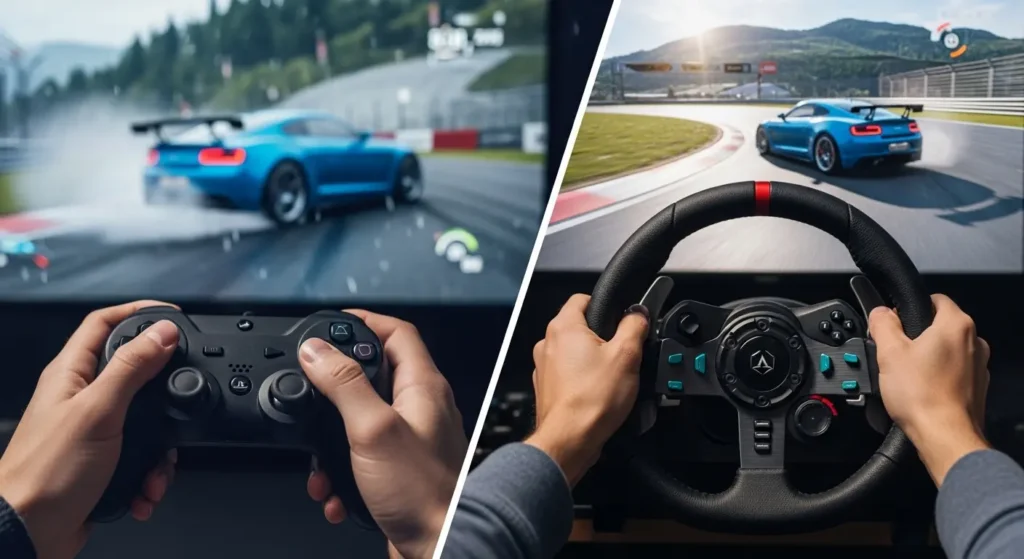
Before we dive into the technical details, let’s affirm your decision. Why make the leap? Is a racing wheel truly worth it? In a word: absolutely.
A gamepad controller is a brilliant, versatile tool for countless genres. For platformers, RPGs, and even casual arcade racers, it’s often the best tool for the job. But for any game that simulates realism—from Gran Turismo 7 and Forza Motorsport to hardcore PC sims like Assetto Corsa Competizione and iRacing—a controller is a fundamental limitation.
It’s a bottleneck that holds back your true potential in three key areas.
A Leap in Driving Precision
A thumbstick offers maybe an inch of travel from its center to its edge. A racing wheel offers 900 degrees or more of rotation. This massive increase in range allows for infinitesimally small, precise corrections that are simply impossible with your thumb. You can apply the exact amount of steering input needed to kiss an apex or catch a slight slide. The result? Smoother driving, better tire management, and more consistent lap times.
From Seeing the Race to Feeling It: The Power of Immersion
With a controller, you see a bump on the screen, and your controller might vibrate vaguely. With a good racing wheel, you feel that bump jolt through your hands. You feel the weight of the car shift as you enter a corner, you feel the tires begin to lose traction under acceleration, and you feel the subtle vibrations of the engine through the steering column. This rich, sensory feedback is the core of sim racing immersion, transforming the experience from passive observation to active participation.
Developing Intuitive Muscle Memory
You cannot build true, reliable driving skills with a vague trigger and a twitchy thumbstick. Braking consistently at the threshold of lock-up requires pressure-based feedback, something only a good pedal set can provide. Your body learns the feel of a perfect corner—how much brake pressure to apply, how progressively to turn the wheel, and when to feed in the throttle on exit. This translates into an intuitive, subconscious driving skill that simply cannot be developed with a gamepad.
All-around input for other games, our guide to choosing a gaming controller can help you find the perfect gamepad for the rest of your library.
The Single Most Important Feature: Force Feedback (FFB)
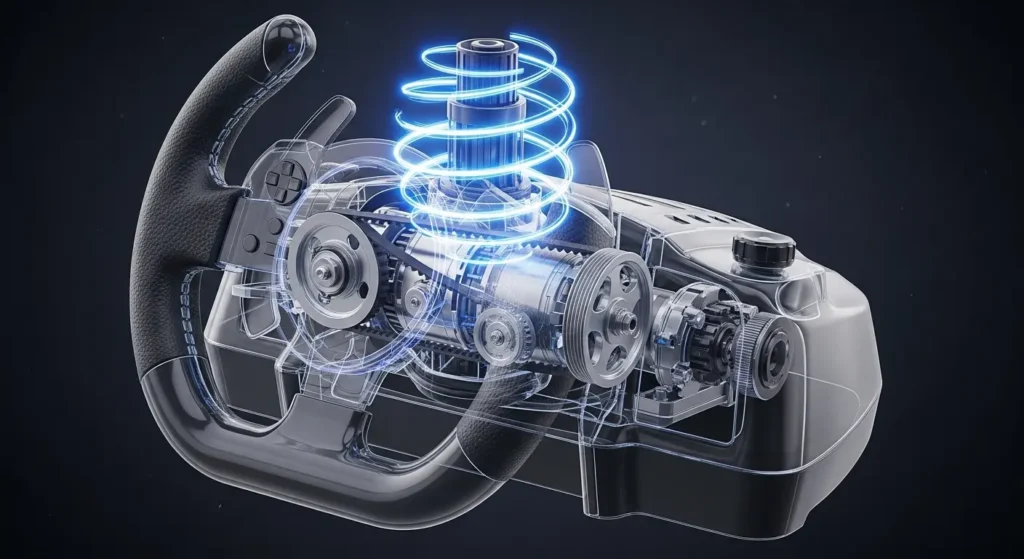
If you take only one thing away from this entire guide, let it be this: Force Feedback (FFB) is the single most important feature of any racing wheel. It is the defining technology that separates a toy from a simulation tool.
A wheel without FFB is a passive device; you turn it, and the car on screen turns. A wheel with FFB is an active, communicative device. The game’s physics engine sends signals to a motor inside the wheel, which generates resistance, jolts, and vibrations to simulate what a real driver would feel through the steering column.
What is Force Feedback and Why is it a Game-Changer?
Imagine driving your real car. As you turn, you feel the resistance of the tires on the pavement. If you hit a pothole, the wheel jolts in your hands. If you start to lose grip on a wet road (understeer), the steering suddenly feels light and vague.
This is what FFB replicates. It provides a constant stream of information:
- Tire Grip: You can feel the exact moment your tires start to slip, allowing you to catch a slide before it becomes a spin-out.
- Road Surface: You can feel the difference between smooth asphalt, bumpy curbs, and slippery grass.
- Weight Transfer: As you brake hard into a corner, you’ll feel the steering get heavier as the front tires load up with weight.
- Vehicle Damage: If you damage your suspension, you might feel a persistent pull to one side.
Force Feedback is your sense of touch. It allows you to drive proactively, reacting to what you feel is about to happen, rather than reactively to what you see has already happened. It’s the key to consistency, immersion, and ultimately, speed.
The 3 Tiers of Force Feedback: From Basic to Pro-Grade
FFB isn’t a single technology; it’s a category with distinct levels of quality, complexity, and cost. The mechanism used to generate the force dictates the fidelity, smoothness, and power of the experience. Understanding these three tiers is critical to matching a wheel to your budget and expectations.
1. Gear-Driven FFB (Entry-Level)
This is the technology that brought force feedback to the mainstream. It’s the system used in the most popular and longest-running wheel series on the market, most notably the Logitech G923/G29/G920.
- How it Works: The motor is connected to the steering shaft via a set of plastic or metal gears. As the motor turns, the gears translate that motion into force you feel at the wheel.
- Pros:
- Affordability: This is the most cost-effective way to implement FFB, making these wheels the best entry point for beginners.
- Reliability: The technology is mature and has been refined for decades, leading to very durable products.
- Cons:
- “Notchy” or “Cogging” Feel: As the gear teeth mesh, you can sometimes feel a slight bumpy or grainy sensation during small movements, which can mask finer details from the road.
- Noise: The gears can produce a distinct rattling or grinding sound during aggressive force feedback events.
- “Deadzone”: There can be a small area of slack in the center where the gears aren’t fully engaged, leading to a slight lack of feeling when the wheel is straight.
- Best For:
- Beginners taking their first step away from a controller.
- Casual racers who want immersion without a major financial commitment.
- Gamers on a strict budget.
- Prime Example: Logitech G923. It’s the quintessential gear-driven wheel and a fantastic starting point for millions of racers.
2. Belt-Driven FFB (The Sweet Spot)
This is the mid-range tier and, for many years, has been considered the sweet spot for serious sim racers who want a significant upgrade over entry-level gear systems without the extreme cost of professional-grade hardware.
- How it Works: Instead of direct gears, this system uses a belt and pulley system to connect the motor to the steering shaft. Think of it like the timing belt in a car’s engine.
- Pros:
- Smoothness: The belt smooths out the motor’s inputs, eliminating the “notchy” feel of gear-driven systems. This results in a much more fluid and realistic steering feel.
- Detail & Nuance: The smoother delivery allows finer details from the simulation—like subtle changes in tire grip or road texture—to come through more clearly.
- Quieter Operation: Belt systems are significantly quieter than their gear-driven counterparts.
- Cons:
- Higher Cost: This technology is more complex and expensive to manufacture.
- Slight Dampening: The belt itself can slightly dampen or “soften” the sharpest, most instantaneous impacts compared to a direct-drive system.
- Best For:
- Serious hobbyists and dedicated sim racers.
- Players looking for a major, noticeable upgrade in realism and performance.
- Anyone who values smooth, detailed feedback for competitive driving.
- Prime Example: Thrustmaster T300RS GT. For years, this has been the benchmark for what a high-quality, mid-range belt-driven wheel can offer.
3. Direct-Drive (DD) FFB (The Ultimate Experience)
Once the exclusive domain of professional training simulators and the wealthiest enthusiasts, Direct Drive technology has become more accessible in recent years and represents the pinnacle of force feedback technology available to consumers.
How it Works: This is the purest form of force feedback. There are no gears or belts. The steering wheel is mounted directly to the output shaft of a high-torque industrial servo motor.
Pros:
- Unmatched Fidelity: With no intermediate mechanism, there is zero dampening, lag, or “lossiness.” You feel every single detail the simulation sends, from the smallest ripple in the asphalt to the most violent curb strike, with incredible clarity and speed.
- Power & Dynamic Range: DD wheels have a much higher peak torque (measured in Newton-meters, or Nm). This isn’t just about making the wheel heavy; it’s about having the power to replicate massive forces instantly, creating a stunningly realistic dynamic range.
- Instantaneous Response: The reaction time is virtually instant. The moment the simulation calculates a force, you feel it. This is crucial for catching slides and making micro-corrections at the limit of grip.
Cons:
- Very High Cost: While becoming more affordable, DD systems are still a significant investment, often starting where high-end belt-drive systems top out.
- Requires Sturdy Mounting: The power of these wheels means they cannot be simply clamped to a flimsy desk. They require a very sturdy desk, a wheel stand, or preferably, a rigid sim-racing cockpit to handle the forces.
- Potential for Injury: At their highest settings, these are powerful motors that demand respect. They are not toys.
Best For:
- Hardcore sim racers and esports competitors.
- Enthusiasts for whom ultimate realism and performance are the top priorities.
- Anyone building a “no compromises” racing setup.
Prime Examples: Fanatec CSL DD / GT DD Pro (pioneered the “entry-level” DD market), Moza R9, Simucube 2 Sport/Pro (high-end).
Step 2: Ensuring Compatibility with Your Gaming Platform
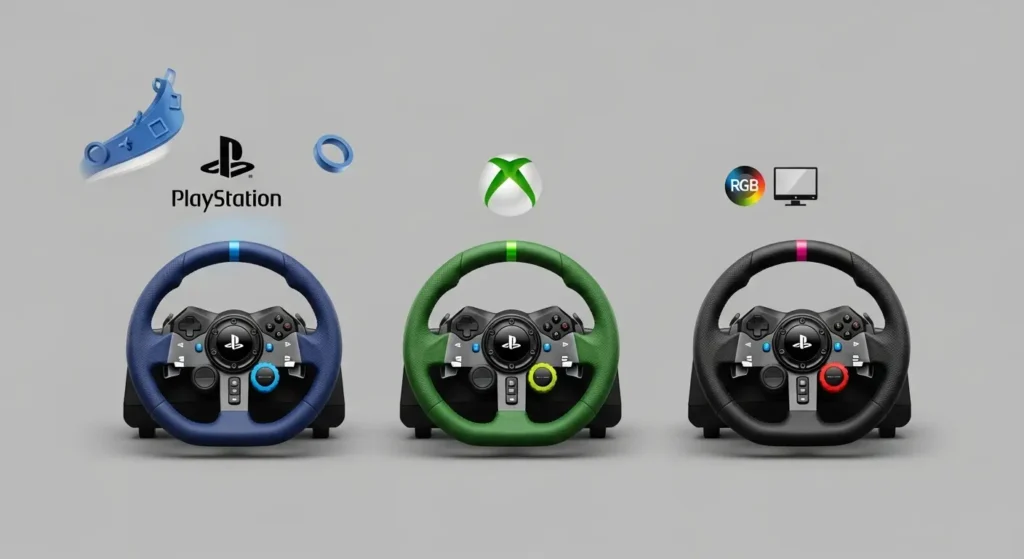
You’ve successfully navigated the most complex technical aspects and found a wheel with the perfect FFB technology for your budget. This is a huge step. However, before you finalize your decision, we must address an equally crucial checkpoint: ensuring your chosen wheel will actually work with your gaming system.
This isn’t a minor detail; it is the single most common and costly mistake a beginner can make. It’s easy to get excited about torque ratings and belt-drive smoothness, only to overlook the one fundamental specification that determines if the wheel is a high-performance tool or an expensive paperweight for your specific setup.
Imagine the excitement of unboxing your brand-new gear, followed by the crushing disappointment when your console refuses to recognize it. This isn’t a bug you can fix with a driver update; it’s a fundamental hardware limitation. Let’s make sure that doesn’t happen to you.
The Golden Rule: PlayStation, Xbox, and PC are Separate Worlds
This is a non-negotiable rule you must understand: A wheel designed for PlayStation will not work on an Xbox, and a wheel designed for Xbox will not work on a PlayStation.
This isn’t an arbitrary decision by the manufacturers. Both Sony and Microsoft require a specific, licensed security chip to be embedded in any peripheral that connects to their consoles. A wheel must have the official PlayStation chip to be recognized by a PS4 or PS5, and it must have the official Xbox chip for an Xbox One or Series X|S.
PC Compatibility
The PC is the “universal platform.” Nearly all racing wheels, whether they are branded for PlayStation or Xbox, will also work on a PC. The PC ecosystem is open, so it doesn’t require these proprietary security chips. This makes PC the most flexible and future-proof platform for sim racing.
PlayStation Compatibility (PS4 & PS5)
When shopping, you will see wheels explicitly labeled “PlayStation Compatible” or featuring the PlayStation logo. These are the only wheels that will work. Note that most licensed PS4 wheels are forward-compatible with the PS5.
Xbox Compatibility (Xbox One & Series X|S)
Similarly, wheels for Xbox will be labeled “Xbox Compatible” or “Licensed for Xbox.” Only these will work on Xbox consoles. Most licensed Xbox One wheels are forward-compatible with the Xbox Series X and S.
Your Actionable Checklist:
- Identify your primary gaming platform.
- Filter your search exclusively for wheels compatible with that platform.
- If you game on both consoles, you have two options: buy a wheel base that has interchangeable steering wheels (some of which carry the Xbox chip), or, more realistically, buy two separate wheels.
Beyond the Wheel: Analyzing the Critical Components
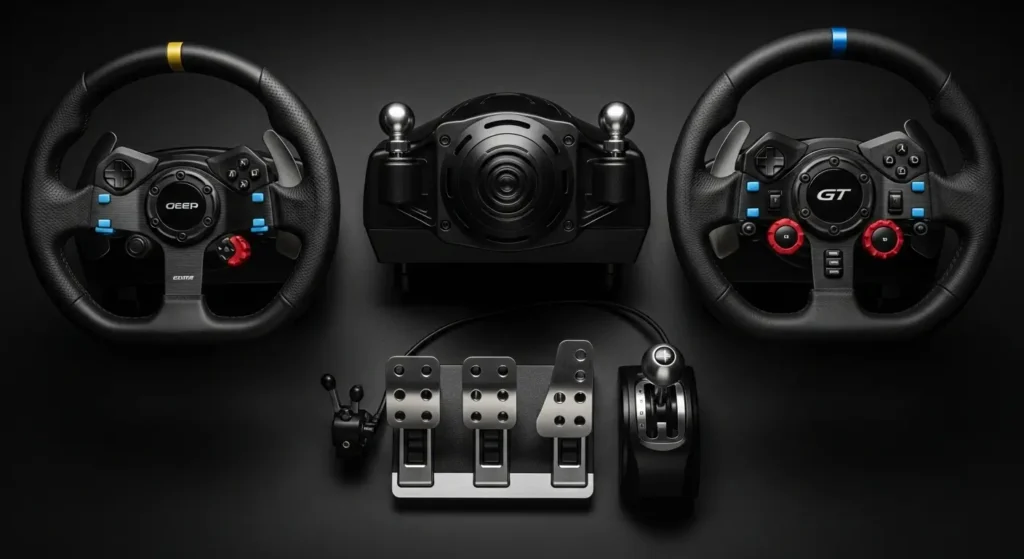
While the wheel base contains the all-important force feedback motor, it’s a common mistake to focus on it exclusively. A racing wheel “kit” should be viewed as a complete system, where the overall performance is only as strong as its weakest link. The parts you physically touch are just as vital to the experience.
Think of the wheel rim and the pedal set as your primary sensory inputs. The texture, diameter, and shape of the rim you hold determine your comfort and control during long race stints. More importantly, the quality of your pedals dictates your ability to consistently modulate the throttle and brake, which is the absolute foundation for setting fast, repeatable lap times.
This is where the concept of modularity becomes critical in higher-end systems. Brands treat each component—the base, the rim, the pedals—as an upgradable part of a larger ecosystem. Your initial purchase isn’t an endpoint; it’s a starting point, allowing you to improve individual components over time as your skill and budget grow.
Wheel Rims: Size, Material, and Rotation
The wheel rim itself is your primary point of contact. Its design profoundly affects how you interact with the car.
- Size (Diameter): Wheel rims are measured in millimeters (mm). Cheaper, entry-level wheels often have smaller rims (around 280mm), which can feel a bit toy-like. Higher-end wheels offer larger, more realistic rim sizes (300mm-320mm), which feel more authentic and provide better leverage against strong FFB.
- Material: The materials determine the tactile feel and longevity.
- Plastic/Rubber: Common on entry-level wheels. Functional and durable, but can feel cheap.
- Leather: A huge step up in premium feel. Comfortable for long sessions.
- Alcantara: A synthetic suede-like material popular in real race cars. Offers fantastic grip, especially with gloves, but requires regular cleaning to prevent matting.
- Rotation: This refers to how far the wheel can turn from its leftmost point to its rightmost point. Most modern wheels offer 900 to 1080 degrees of rotation. This is crucial for realism, as it mimics the rotation of a real road car. This allows for smooth, large steering inputs, essential for drifting or navigating tight hairpins. For F1 or GT style racing, you can often adjust the rotation down to a smaller range (e.g., 360-540 degrees) in the software to match the real car.
The Pedal Set: Your Connection to the Road
If the wheel is your sense of touch, the pedals are your connection to the car’s soul—the engine and the brakes. A poor pedal set can be a massive bottleneck, especially when it comes to braking.
2-Pedal vs. 3-Pedal Sets
Most entry-level kits come with a 2-pedal set (throttle and brake). This is perfectly fine for most racing, especially in modern race cars that use paddle shifters. A 3-pedal set adds a clutch. You only need a clutch if you plan to purchase a separate, optional H-pattern shifter to simulate driving a classic manual car.
The All-Important Brake: Potentiometer vs. Load Cell
This is the single most important differentiator in pedal technology, and arguably the biggest upgrade you can make for driving consistency.
- Potentiometer Pedals: These are found in all entry-level and most mid-range pedal sets. They work by measuring the distance the pedal has traveled. To get 50% braking, you push the pedal down 50% of its total travel distance. The problem? It’s very difficult for your brain to precisely and consistently remember a specific distance.
- Load Cell Pedals: This is a much more advanced and realistic technology. A load cell is a sensor that measures pressure or force, not distance. To get 50% braking, you apply 50% of the maximum required pressure. This is exactly how a real car’s hydraulic brake system works.
The advantage of a load cell is immense. Your brain and muscles are far better at remembering pressure than distance. This “muscle memory” allows you to brake at the absolute limit, lap after lap, with incredible consistency. Upgrading from a potentiometer brake to a load cell brake will almost certainly make you a faster, more consistent driver.
Shifters: Paddles, Sequential, and H-Pattern
The final piece of the control puzzle is how you change gears.
- Paddle Shifters: These are the metal or plastic paddles located behind the steering wheel. Nearly every racing wheel on the market includes them. They provide instant, crisp shifts and are the standard for almost all modern F1, GT, and prototype race cars.
- Sequential Shifter (Optional): This is a separate lever you mount to your rig. You push it forward to downshift and pull it back to upshift (or vice versa). It provides a satisfying, chunky, mechanical feel and is popular for rally games and touring cars.
- H-Pattern Shifter (Optional): This is another separate unit that simulates a traditional manual car’s gearbox, with 6 or 7 gears and a reverse. It requires a 3-pedal set with a clutch and provides the ultimate immersion for driving classic road cars.
Planning Your Setup: Budget, Mounting, and Ecosystems
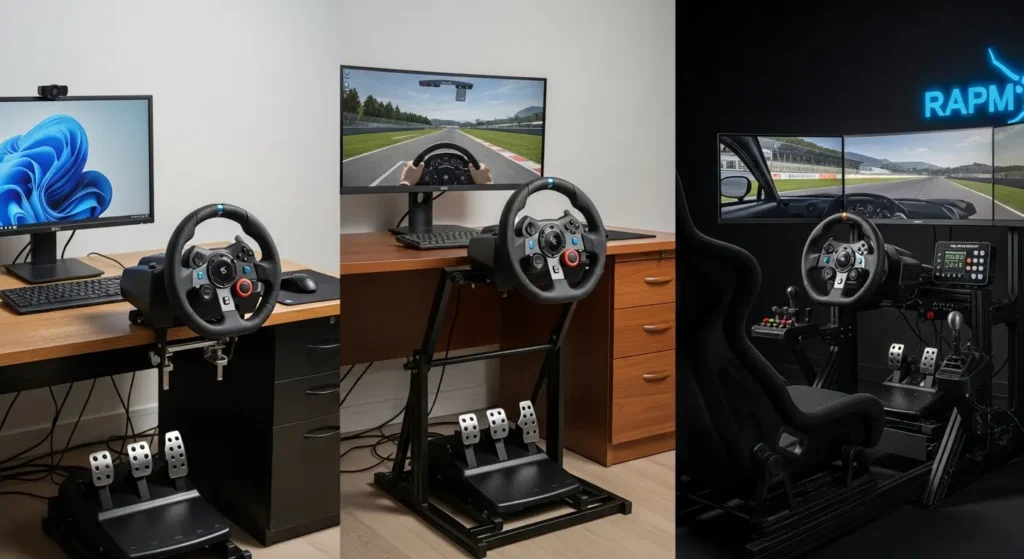
You’ve mastered the technology behind force feedback, pedals, and platform compatibility. Now, we must address the practical logistics. A racing wheel is not just a peripheral you plug in; it is the centerpiece of your driving environment.
Planning for this “environment” from the very beginning is crucial. How you mount your wheel and where you place your pedals directly impacts the effectiveness of the hardware you’ve so carefully chosen. A poor setup can negate the benefits of even the most expensive equipment.
Thinking about these practical steps now will save you from future headaches, frustration, and costly re-buys. Let’s build a stable foundation for your sim racing station.
How Will You Mount Your Wheel?
Where you place your wheel is just as important as the wheel itself. An unstable mount will cause the FFB to be lost in wobbling and flexing, ruining the experience.
- Clamping to a Desk: This is the most common starting point. Most wheels come with a built-in clamp system. Works well for: Gear-driven and lower-power belt-driven wheels. Potential Issues: Desks can wobble, pedals can slide on the floor, and the ergonomics (chair height, desk height) are often not ideal for driving. Not recommended for Direct Drive wheels.
- Foldable Wheel Stand: These are dedicated metal frames for your wheel and pedals. They are much more stable than a desk and can be folded away for storage. Works well for: All gear-driven and most belt-driven wheels. A great compromise for those who can’t have a permanent setup.
- Full Sim-Racing Cockpit: This is a dedicated seat and frame onto which you bolt your wheel, pedals, and shifter. This is the ultimate solution. It provides rock-solid stability, perfect ergonomics, and unmatched immersion. A rigid cockpit is essential for getting the most out of a Direct Drive wheel.
Understanding Brand Ecosystems (Logitech, Thrustmaster, Fanatec)
When you buy a wheel, especially from brands like Thrustmaster or Fanatec, you are often buying into an ecosystem.
- Logitech: Generally offers all-in-one packages. The wheel, base, and pedals are designed to work together and are not typically interchangeable.
- Thrustmaster: Offers a strong ecosystem. You can buy a base (like the T300) and then upgrade the wheel rim or pedal set later, and it all works together seamlessly.
- Fanatec/Moza: The masters of the modular ecosystem. You buy the wheel base, wheel rim, pedals, and shifter as separate components, allowing for near-infinite customization. However, you are generally locked into using their components together.
Think about your future upgrade path. If you just want to buy one thing and be done, Logitech is simple. If you think you might want to upgrade your pedals or rim in a year, Thrustmaster or Fanatec offer that path.
How Much Should You Spend on a Racing Wheel?
Let’s put it all together into practical budget tiers. These prices are general and include the wheel and pedals.
- The Beginner (Up to $400): This is the domain of gear-driven wheels like the Logitech G923. It’s the perfect entry point to see if the hobby is right for you. You get full FFB, decent pedals, and a reliable package that will provide countless hours of fun.
- The Serious Hobbyist ($400 – $900): This is the belt-drive and entry-level Direct Drive tier. Here you’ll find the Thrustmaster T300RS GT or the Fanatec CSL DD (5Nm) Ready2Race Bundle. The jump in FFB quality and detail in this bracket is the most significant leap you can make. This is the sweet spot for performance per dollar.
- The Hardcore Enthusiast ($900+): Welcome to the world of high-end Direct Drive. This includes higher-torque DD bases from Fanatec, Moza, or Simucube, paired with premium load cell pedals and high-quality rims. This is for those seeking the ultimate in realism and performance with no compromises.
Ready to Race? Our Top Picks for 2025
Now you are armed with the knowledge to make an expert decision. You understand the nuances of Force Feedback, the critical importance of a load cell brake, the rules of compatibility, and the practicalities of mounting and budgets. You know what separates a good wheel from a great one.
The next logical step is to see how this theory applies to specific products on the market today. To help you cross the finish line, we’ve tested, reviewed, and compiled the best options available.
For our specific, hands-on recommendations, check out our complete, in-depth guide to the 10 Best Racing Wheels for Realistic Driving in 2025.
Frequently Asked Questions (FAQ)
Q1: Do I need a racing wheel with a clutch?
You only need a clutch if you intend to buy a separate H-pattern shifter to simulate driving a traditional manual car. For over 95% of racing in modern games (F1, GT, prototypes), the included paddle shifters are all you need, and a 2-pedal set is perfectly sufficient.
Q2: Is a Direct Drive wheel worth it for a beginner?
While a DD wheel offers the best experience, it can be overkill for a complete beginner. The jump from a controller to a good gear or belt-driven wheel is already monumental. We recommend starting in the Beginner or Hobbyist tier. If you fall in love with the hobby and have the budget and space for a rigid mount, then a DD wheel is the ultimate upgrade path.
Q3: Can I use my PS5 racing wheel on my PC?
Yes. Almost all modern PlayStation or Xbox licensed wheels are designed to work perfectly on a PC via a standard USB connection. The PC is the universal platform for sim racing hardware.
Q4: How important is a load cell brake pedal, really?
Extremely important. If you have to choose between a better wheel base with standard pedals, or a slightly lesser wheel base with upgraded load cell pedals, choose the load cell pedals every time. It is the single biggest hardware upgrade that translates directly to more consistent and faster lap times.
